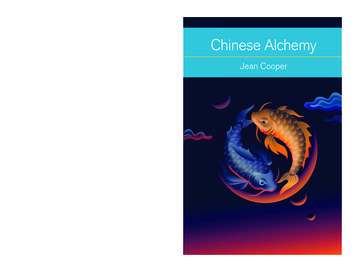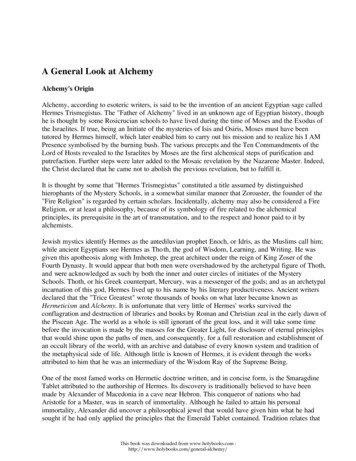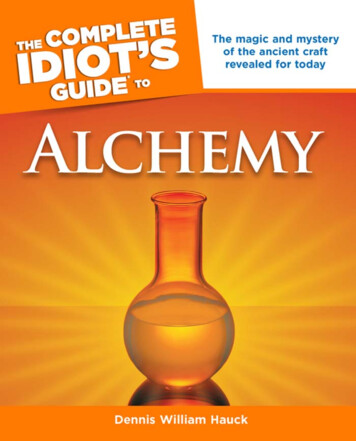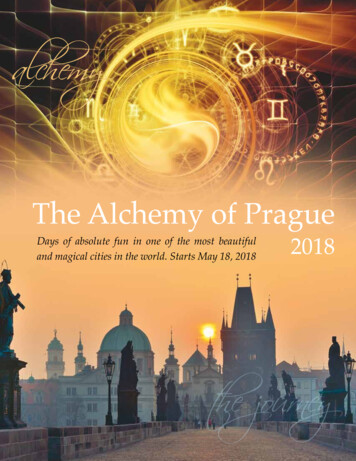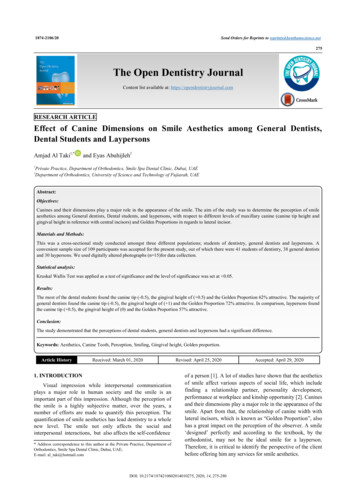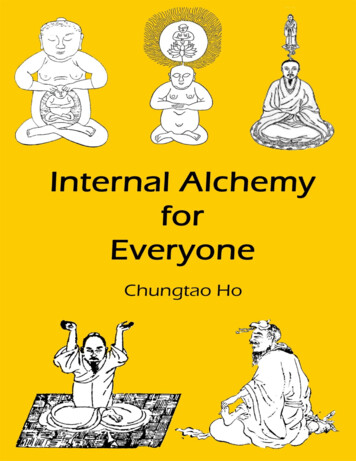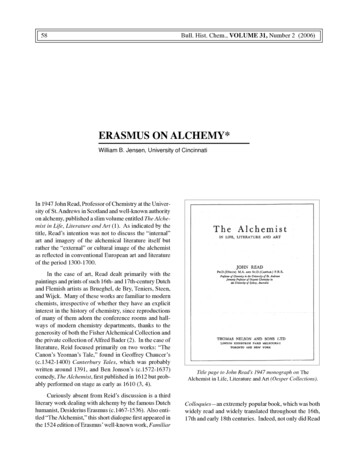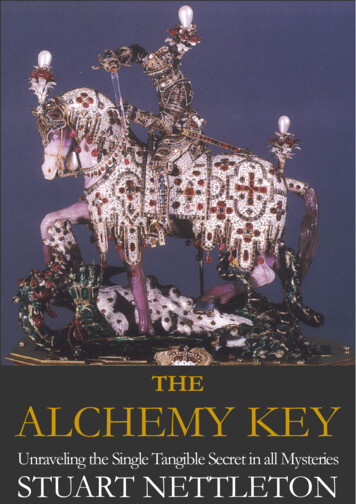
Transcription
THEALCHEMY KEYUnraveling the Single Tangible Secret in all MysteriesSTUART NETTLETON
The Philosophers’ Stone was sought as a wonderful medicine that had thepower to repair the human body thereby increasing human life almostindefinitely. The Bible itself had declared that Melchizedek the King ofSalem, who first possessed the Philosophers' Stone, would live forever Here is a key. Perhaps you willuse it to open a new door.Beware! Once through the dooryou will find the pursuit ofWisdom demands either your fulltime attention or none at all. Ifyou become a philosopher, yourfriends may think you havebecome a little mad. Indeed, whatwould be made of you? Glassyeyed, preoccupied, strange friends,muttering about ancient history,the Good and the Righteous, andchemistry. Things most peoplesimply don't think about.Those who have preceded you for at least five thousand years wouldsmile: ‘How you come to terms with this is no concern of ours. We don'teven know if you are serious.’I SBN 0 - 6 4 6 - 3 4 0 2 2 - 0St George & the DragonTreasury of the Munich Residence, 1586
I dedicate this work to the Alchemists, Rabbis, Historians, Philosophers,Freemasons and other friends who have encouraged my search for truthand helped me in so many small steps.Stuart Nettleton’s interests lie in the mysteries and sciences of alchemy.
The Alchemy KeyThe Mystical Provenance of the Philosophers' StoneStuart Nettleton
Published by Stuart NettletonISBN 0646340220Copyright Stuart Nettleton, Sydney, AustraliaAll Rights Reserved.1st Edition 1998; 2nd & 3rd Edition 1999; 4th Edition 2000;5th to 7th Edition 2001; 8th to 11th Edition 2002Nettleton, Stuart 1952The Alchemy Key: The Mystical Provenance of the Philosophers' Stone1. Alchemy2. Gold3. Philosophy - Ancient4. Philosophy - Medieval5. Hermeticism6. Holy Grail7. Freemasonry8. Rosicrucianism9. Judaism10. Egypt - Religion - Influence11. Bible - Old Testament Criticism, Interpretation etc12. Bible - New Testament Criticism, Interpretation etc13. Chemistry - History14. Chemistry - ModernThe moral right of the author has been asserted. All drawings anddiagrams are the work of the author unless otherwise indicated.Condition of Sale: All rights reserved. This publication may not bereproduced, stored in a retrieval system, or transmitted, in any form or byany means, electronic, mechanical, printing, photocopying, recording orotherwise, without the prior permission of the publisher.Permissions: The publisher has made every effort to trace and contact allcopyright holders of reproduced copyright materials in this book. Thepublisher will be glad to rectify any omissions at the earliest opportunity.Frontispiece: Statuette of St George, Munich & Augsburg, 1586-1597 &1638-1642, Treasury of the Munich Residence, 1995 BayerischeVerwaltung der staatlichen Schlösser, Garten und Seen, München
Dear friend, theory is all grey,And the golden tree of life is green.Johann Wolfgang von Goethe, Faust Pt.1Two souls dwell, alas! In my breast.Johann Wolfgang von Goethe, Faust Pt.1The outcome was philosophical dualism with all the tragic-comic woesattendant on spiritual dichotomy.Robert Graves, The White GoddessThe gods did not reveal, from the beginning, all things to us, but in thecourse of time through seeking we may learn and know things better. Butas for certain truth, no man has known it, nor shall he know it, neither ofthe gods nor yet of all things of which I speak. For even if by chance hewas to utter the final truth, he would himself not know it: For all is but awoven web of guesses.Xenophanes of Colophon, 500BCEThere were several roads nearby, but it did not take her long to find theone paved with yellow bricks. Within a short time she was walkingbriskly toward the Emerald City, her silver shoes tinkling merrily on thehard, yellow roadbed The next morning, as soon as the sun was up, theystarted on their way, and soon saw a beautiful green glow in the sky justbefore them. ‘That must be the Emerald City’ said Dorothy.L Frank Baum, The Wonderful Wizard of OzThe word ‘rose’ is manna to the lyricist.John Fisher, The Companion to RosesOutward ritual cannot destroy ignorance, because they are not mutuallycontradictory. Realized knowledge alone destroys ignorance Shankara, Father of the Swami OrderThe only honour that man can pay his Creator is to seek Him.Swami Sri Yukteswar GiriStibnite: Sb2S3 Antimony Sulfide Gray-metallic with orthorhombic,slightly flexible crystals, often radiating blades. Associated with gold,cinnabar, galena, barite and quartz. From the Greek name ‘stibi’, usedto describe antimony, which was used to separate gold by the ancients.Mineral GalleryBefore enlightenment you chop wood and carry water After enlightenment you chop wood and carry water i
ContentsChronologyivPreface1Introduction6Chapter 1 Arcane Alchemy11Chapter 2 David Hudson’s Alchemy17Chapter 3 Enigma of King Solomon's Temple25Chapter 4 Crucibles of Humanity45Chapter 5 Anatolian Commagene & Israelites64Chapter 6 Hyksos Invasion of Egypt95Chapter 7 The Name of God, the Merkabah and Liberality 113Chapter 8 Sabians of Harran and Yemen127Chapter 9 Hasmonaeans, Pharisees & Zaddoki140Chapter 10 Zaddoki & Jesus145Chapter 11 Melchizedekians and Merovingians153Chapter 12 The Tribe of Dan162Chapter 13 Corpus Hermeticum & Gnosticism192Chapter 14 Ancient Alchemy201Chapter 15 St George and the Dragon224Chapter 16 Green and Lilac244Chapter 17 Roses and Rosicrucians258Chapter 18 Architecture, Freemasonry & Knights Templar 292Chapter 19 The Philosophers’ Stone and Manna336Chapter 20 The Ancient of Days352Chapter 21 Et in Arcadia Ego362Chapter 22 The Holy Grail378Conclusion383Appendix 1 Preparing the Philosophers' Stone386Appendix 2 Roger Bacon’s Method392Appendix 3 King Solomon's Method402Appendix 4 The Virgin of the World404Appendix 5 Bacon's Description of the Goddess406Appendix 6 Ovid's Metamorphoses408ii
Appendix 7 Crata Repoa412Appendix 8 The Perfect Pyramid416Appendix 9 A Note on the Scholar Robert Graves425Appendix 10 Atbash Cipher426Appendix 11 Triangular Manuscript of Comte St Germain 428Appendix 12 Painted Ceilings at Crathes Castle433Appendix 13 Jewish Rites of Tammuz438Footnotes460References492Index504iii
ChronologyYrs Ago125-65 mi40 million30-20million8.2-12million7 million5.8million5 million3.75 mill.3 million1 012,00010,000Indo-HittiteAfro-AsiaticRat-like Mus is common ancestor of humans and miceAncestors the Dryopithecines live in trees.Amphipithecus in AsiaAegyptopithecus orPropliopithecus in AfricaHuman descent splitsHuman descent splits fromfrom Gibbon descentGorilla/ChimpanzeeHuman descent splitsfrom OrangutanFossils absent as hominoids become wadersEthiopian Ardipithecusramidus kaddaba(Earliest human ancestor)Human descent splitsfrom GigantpithecusEthiopian ‘Lucy’Australopithecus afafensisFossils again found - HomoHabilusJava ManInvention of FireSangiran or the PekingMan in JavaAsian Neanderthal SoloMan or Tien ShanAsian Homo SapienAfrican Homo Sapien(Sapien)(Sapien): Cro-MagnonFirst Ice AgeIndo-Hittites eliminate Neanderthals of EuropeIndo-Hittites populateAsgar in Northern IndiaFirst Ice Age thawsSnap Ice AgeCaucasian migration toSumer, Bactria, Europeiv
ttiteEarly Copper WorkingUrban civilization inSumer with coppersmelting, goldworking,beer and wineKurgans (Barrow) enterEurope above Black Sea2nd wave Kurgans toEurope3rd wave Kurgans toEuropeEarly Iron WorkingAfro-AsiaticEgyptian Urban civilizationBeakers invade Ireland &WalesKurgan (Barrow) peoplein Ireland1,300Picts an King Sargon Iinvades SumerGutians from ZorebMountains conquerAgadeSemitic Amorites attackSumer21202020EgyptPharaoh Djoser &Architect Imhotep1st 12th-Dynasty PharaohAmenemhe I2nd 12th-Dynasty PharaohSesôstris I19791959v
BCE1950Mesopotamia19171900Hittites invadecentral Anatolia4th 12th-DynastySesôstris II5th 12th-DynastySesôstris III6th 12th-DynastyAmenemhe eSesôstris I exerts suzerainty overAnatolia and Palestinerd3 12th-DynastyAmenemhe IIKing Hammurabi7th 12th-DynastyAmenemhe IV8th 12th-DynastySebeknofruHyksos Invade Egypt.AbrahamIsaacEruption of Thera (Santorini)2nd eruption Hekla III in IcelandHyksos expelled from EgyptTuthmose III's Palestine campaignConventional Date for ExodusConventional Date Moses’ deathJerusalem ruled by Semitic vassalof EgyptPharaohAkhenatenPharaohTutankhamunvi
BCE1300AssyriaAssyria controlsthe 586549529529522538522486486465330EgyptIsraelRamses II re-exerts suzerainty overPalestine and SyriaLatest Date for ExodusJoshua3rd eruption of Hekla III in IcelandDavidSolomonAssyriansconquernorthern Israel10 tribesdeported toAssyriaExile toBabylonCyrus the GreatCambyses IIPersians ConquerEgyptReturn fromExileDarius the GreatXerxesManetho &Hekataios ofAbderavii
BCEGreek638559624546570510530456SolonAthenian PhilosopherThales & AnaximanderMilesian SchoolPythagorasItalic SchoolXenophanes &ParmenidesEleatic SchoolHerodotusThe Father of HistorySocrates & PlatoAthenian PhilosophersEudoxus of Knidos484420468347400350384322BCE760681Israelite / JewishAmos, Hosea, Isaiah &Micah626571530Jeremiah & Ezekiel480Zechariah430NehemiahDaniel & HaggaiAristotleAthenian PhilosophersSchools of Greek and Israelite/Jewish Philosophyviii
PrefaceColleagues often ask me why I wrote this unusual book. At first,it was simply so I could sleep at night. It was a way to marshal theextraordinary facts and histories that constantly rotated in my mind andbecame graphically alive at bedtime! Now I think my reason is to restore,in a humble way, richness to the mystery tradition at a time when the oldarts of the philosopher are all but lost.There are many paths to the mysteries. The most predominantorganizations in western societies are usually composed of people wemight call literalists. They would not like the more accurate label of antiphilosophers. Literalists believe their traditional histories are unique,explain everything and provide enough wisdom to make the rest ofcivilization irrelevant. Usually, they treat their stories as fact rather thanmyth and rarely think about it any further. These people often join manysocieties; yet groan at the mention of a lecture. Archeology providesthem interesting asides but discoveries are rarely important enough tochange the faith.Then there are capital P and small p philosophers. Capital Pphilosophers deride literalists and small p philosophers alike asfundamentalists, a dirty word. These capital P philosophers know allmyths are just that, myths without a historical basis. Unless archeologyproves something happened then it did not, and the myth is just a storyhaving no more merit than a fairy-tale.This book is for the small p or Gnostic philosophers who have abit each way when it comes to myth. They see myth as having merit andare not surprised when archeologists discover a Troy, or if they hear astory in the Bible is proved true. Most think that Atlantis will eventuallybe located. Small p philosophers see myths representing importantelements of culture and if not based on facts then often based on softfacts. One such soft fact is alchemy. Its goal is the Philosophers’ Stone.This book traces the chemistry and philosophy of thePhilosophers’ Stone from first dynasty Egypt and Mesopotamia throughthe Commagene region of Turkey, to Israel, France and England. Itparticularly focuses on mystery religions and philosophical schools thatco-existed over thousands of years.The keys to understanding the Commagene region are metallurgyand alchemy. There is a remarkably close connection between metals,alchemy, perhaps the true Holy Grail and many esoteric traditions of the1
Israelites, Freemasons and Rosicrucians. Surprisingly, these traditions areonce again contributing to leaps in modern medicine and industrialtechnology.Many will see the topics in this book as forbidden territory. Eventoday, in this age of science, the subjects of alchemy and mystery religionremain fused with intolerance. It is only in today’s postmodern westerndemocracies, freed from religious oppression, superstition and mastertheories that we can listen to the cacophony of simultaneous voiceswithout declaring enemies or being declared an enemy.Throughout history, many lives have been lost in pursuit of theillusive Philosophers' Stone. Few have found the wisdom to truly beholdit because it is a process and not an end in itself. The reader shouldtherefore regard this book as a philosophical base station at the foot of thehighest mountain of Wisdom. It seeks to understand the philosophy ofalchemy, its peculiar chemistry and the surprising and pervasive role ithas played in the development of human culture through the mysteryreligions.In a sense, alchemy has come full circle since translation of thegreat Arabic texts into Latin in the tenth century CE. Alchemy was theprecursor to chemistry and pharmaceuticals. Now the sciences ofchemistry, physics and information are on the threshold of making thehidden benefits of alchemy widely available.David Hudson, a farmer from Phoenix, Arizona, has beencarrying out technical research into the Philosophers' Stone for twodecades. His work has helped galvanize many of the themes in this book.Hudson’s influence is everywhere through this work as much as that ofRobert Graves and Sir Karl Popper.1 Stephen Skinner’s excellent bookLapidus – In Pursuit of Gold also proves to be a treasure on alchemy.The author would also like to thank Tom Simms of New Brunswick,Canada, for his discussion of the New Kingdom and Third IntermediatePeriod in Egypt. Tom’s research has assisted dating the Exodus inChapter 5. The author is very grateful to Robert Word, of San Francisco,for his excellent translation of the Triangular Manuscript of St Germain,the only translation known to exist.Turning to perhaps the most intensively investigated region in theworld, Egypt and Syro-Palestine, we find modern archeology has not yetconclusively unraveled their chronologies. Of the many difficultiesencountered by archeology, none is more confusing than the Biblical useof archetypes. An archetype is a model, projected paragon or ideal.2
Archetypes in old stories are not literal. Authors apply the technique in amidrashic sense.2 Compound characters display all the traits that theauthor seeks to convey to the reader. Some aspects of the characterizationare indeed fact but others merely fantasy. Historical archetypes often playa role in many eras, sometimes under alternative names.Closely associated with the issue of archetypes is the art ofdouble meanings or entendres. Dual and even poly-meanings give rise toa phenomenon called hermetic drift. Umberto Eco has spent much of hiscareer in teaching and writing about hermetic drift. He argues that thehermetic tradition underlying much alchemical literature relies onphysical similitude. This means that everything is similar and closelyrelated to everything else. These relationships are inexhaustible andinclude every element of this world and heaven. Deliberately and withconsiderable delight, authors in the sacred arts of alchemy use HermeticDrift to slip from similarity to similarity and meaning to meaning. Thecontent of every expression and symbol becomes a further enigma, moremysterious than the previous one and the ultimate meaning is inevitablypostponed. Linguistics and symbols entangle the whole subject. Theesoteric elite smugly escape analysis and criticism. As a result, theirtheories are never testable and have very low levels of dependability,known as verisimilitude. At the end of it all, the content can often be anempty secret or something time has otherwise reduced to commonknowledge.Presenting written ideas for positive and constructive criticism isrelatively modern. While many Jewish authors showed admirable candorin post-Medieval times, Western authors were far more clandestine. Theyhad little accountability and were economic with the truth. The extensiveuse of Hermetic Drift in the West means we can only understand theirslippery allegories with good humor, healthy skepticism and a fewtraditional tools such as Occam's Razor.The English philosopher William Occam developed Occam'sRazor in about 1310CE to cope with archetypes and hermetic drift. Hisprinciple of economy in logic simply states that the smallest number ofentities achieves the best theory. The principle demands categorization oftheories for maximum impact. This increases the probability of truth, orverisimilitude. A good theory has predictive value while a poor theorycan explain everything but predict nothing. Limiting the number ofentities usually helps to collapse a large number of threads into a3
surprisingly small number of themes that can more readily be crossvectored to hook a new theory from the pool of conflict and plurality.Mathematically this is the pattern recognition process of clusterand factor analysis in statistics. A top-down, helicopter view overcomesthe problem of being unable to see the forest because the trees are in theway. Occam's helicopter, rises above the trees to see the forest and eventhe pattern of light in its glades. Occam's helicopter will be very useful tous throughout this book because our aim is physical, chemical,mathematical and social analysis rather than description.Notwithstanding the conciseness of this analytical approach, thereader may correctly perceive the method of Occam’s Razor, applied tothe arcane characteristics of alchemy, rambles around the subject. Theauthor has tried to keep a traditional approach to the issues but thelabyrinth ahead will be a challenge with chapter headings that seem morefor convenience than classification. Be of good heart because it promisesto be a grand tour of life, death, the universe and everything, at least asfar as we know it.Sadly, the author cannot promise packaged Wisdom from thejourney, only that the reader will pass by many sites where it is possibleto begin the process of discovery. The reader will need to work quitehard to recognize Wisdom for his or herself. Whether in alchemy or themysteries, practical involvement is the key to Wisdom. The alchemistswould say Ora et labora, or God through Labor. It remains for the readerto choose any of the many practical possibilities.This book meticulously references sources of informationwherever possible. While some of these references are unconventionaland present hypotheses that lead in radically different directions, the workof these authors broadens the scope and spectrum of understanding andprovides many useful insights.Advancement of knowledge in the kaleidoscopic environment ofesoteric philosophy and mysteries is perilous. The cardinal rule is thatevidence must always exist for any hypothesis. The main purpose of thisbook is to assemble and cross-vector arcane knowledge in a new way, tounderpin a new and better understanding of the subject. As in a court oflaw, some evidence is more reliable than other evidence. The author willattempt to warn in advance of the more contentious areas.All errors are of course the author's responsibility alone. Theauthor hopes that any minor aberrations will not obstruct the reader fromgrasping the richness of alchemy in its historical context.4
The great alchemist Zosimus said that everyone should have abook of chemistry. The Alchemy Key will reveal to you works that havebeen unfamiliar to many contemporary readers. Perhaps you will evendiscover your own book of chemistry.Alchemy, the Mystical Provenance of the Philosophers' Stone, isbefore you. To this day, it remains an exciting frontier of science withadrenalin pumping intrigue. Please plunge into the stream and join in thesearch for that which was lost.5
IntroductionLeaning on my elbow, I turn to my own thoughts.The pages of my life, I have cast, on the great millwheel of fortune.In my hunt for the golden crown, I have sought clues, in labours longand wide.I am resolute in my dangerous pursuit.Dangerous you laugh?Yes, I say, for Wisdom is demanding.She does not release her captives readily, but demands inconsideratelabor in searching her ciphers.So as the millwheel turns, I entrust myself between the columns wherethe University of Antiquity awaits.There I am sure the dance of the labyrinth will lead me to the emeraldcity.And Ariadne's silken thread, woven from chains of light, will supportmy journey to the midnight sun.The turn of the millwheel has brought me luck, I cast again God goes with the brave.The alchemical Philosophers' Stone is the main subject of thisbook. It has many names including the Elixir of Life, occult gold, mannaand dew. For thousands of years the knowledge of this marvelous Stonehas been the sole province of mystical brotherhoods including EgyptianPriests and Pharaohs, Melchizedek Priests, Arabian Schools, Rabbis,Kabbalahists, Indian Yogis, Rosicrucians, Freemasons and lone Jewishalchemists.The subject embodies a mix of religion and politics that hasfermented throughout history, occasionally erupting. The earliest traceswe have of this are with first dynasty Egyptian Pharaohs. The trail tracksthe devastating Hyksos invasion of Egypt and the Exodus of the Childrenof Israel from Egypt.Ancient sanctuaries such as Harran and Jerusalem emerge aswarehouses of arcane knowledge. So esoteric is the knowledge that it isfrom lone Jewish alchemists, who perhaps knew the least that we learnthe most. Jewish scholars persistently worked at alchemy and aroundtenth century CE translated the great medical and alchemical treatises ofthe Arabic world. In looking at the Philosophers' Stone, we have cause to6
refer to the Old and New Testaments of the Bible and the Jewish Zohar asparticularly fine mystical records.From the sanctuary of Harran, there was a transfer of alchemyand metallurgy to Islamic Sufism. During the Italian Renaissance, thesame knowledge became available from Constantinople through theenthusiastic acquisition of manuscripts by Cosimo de Medici. FromRenaissance Italy, it made its way to Britain where the Elizabethansreceived it enthusiastically.Ancient Harran generated chains of alchemy and architecture.These led through French cathedral building to the definition of Scottishand English Freemasonry. Links in the chain include the PhoenicianDionysian Artificers, the Roman Collegia, the Magistri Comacini ofComo and the Compagnonnage.From Jerusalem, the Jewish stream split into the RabbinicalKabbalahists of the city of Alexandria, the Qumran Essenes and theGnostics. The Alexandrian stream spilled into Greece, Spain and Irelandwhere it appears to have all but petered-out. The Essene stream endedabruptly with the total Roman suppression of Jewish nationalism in thefirst and second centuries CE. Yet, there are faint but intriguing lines ofsurvival of Melchizedek Priests in the Diaspora of Southern Francethrough to today. The Roman Catholic Church suppressed both theGnostic stream and the Great Heresy of the Bogomils. The formerculminated with the Albigensian Crusade and violent assault onMontségur in 1245CE. Yet, again, stories emerged from the Inquisitionthat four Parfaits smuggled the Cathars' treasure to safety.3Another chain commences around 1128CE with discoveries bythe Knights Templar in Jerusalem. Sheltered in Scotland after theirdissolution, the Knights Templar traditions fused into Scottish guilds ofthe Compagnonnage and later into English Freemasonry. Subsequentlythe German Rosicrucians fled to the protection of James I of Englandduring the Thirty Years War in the early 1600s. From there, theRosicrucians developed a very close affinity with English Freemasonry.They were to amalgamate with the upper degrees of Freemasonry,bringing organizational structure to the whole movement.Alchemy has fundamentally influenced Western society,particularly in medicine and religion. In religion, for example, theEucharist ceremony symbolizes alchemy. We find the rituals of theRoman Catholic Church, involving the congregation as the living church7
in a yearly cycle, embody the complex symbolism of alchemy and theMysteries.Yet, the infamous Faustian objectives of unbelievable wealth andthe Elixir of Life have also kindled the worst of human greed and avarice.The outcome was often disastrous for all involved. Loss of money,counterfeiting, swindles and murder. As a result, alchemy’s daughter,Science, led the world to believe that she had abandoned the pursuits ofher mother in the sixteenth century. However, chemistry, physics,metallurgy, medicine and pharmaceuticals all flourished.This book analyses the closely related development of alchemicalmetals and glass technology from the earliest known practices inAnatolia, Syro-Palestine and Egypt. The Sabians of Harran and Yemen,and the Melchizedek priests of Jerusalem contribute a great deal. Usingknowledge from Hermetic philosophy, we investigate the wet method ofalchemy to find the green and lilac Philosophers' Stones.The importance of Light and Dew emerges from many diversesources such as garden roses, the orders of Rosicrucians and the historicalmilieu of the Knights Templars. We find that the Ancient of Days couldbe much more than a vision of Ezekiel. The romances of the Holy Grailintegrate all of our knowledge of the Philosophers' Stone into aconsummate whole.Yet, our historical background can never be more than informedconjecture based on abundant circumstantial evidence. ConsiderableJewish evidence is contained in the Bible and Kabbalah, both of whichare deeply mystical and archetypal. Even these sources have moreobjective coherence than those of the other major group, the Rosicruciandescendants of the Indo-Hittites. The Rosicrucians prized oral overwritten tradition and have kept almost no records. The Elizabethancanons of literature are prominent exceptions.A new, modern element has abruptly changed this duopoly ofknowledge. Whitegold, the modern Philosophers' Stone, now exists as ascientific fact. Many countries even granted patents. Whitegold spans thegulf of physical credibility in alchemy and integrates biblical mysticismwith the oral traditions of the Rosicrucians. It is the one and only tangibleelement in a sea of subjective cleverness. The chapters that follow buildon this newfound bridge of understanding.Four major theories integrate this work. These are the dynamicsof population interfaces in the Crucibles of Humanity, the emergence ofthe Israelite race, their early homeland aspirations and the ancient heritage8
of the Philosophers' Stone. The Knights Templar rediscovered the ancientJewish heritage while the Rosicrucian heritage flows from the IndoHittites and more particularly the Indo-Iranians.The establishment of the Israelites has traditionally been acontroversial subject for scholars. This book presents a new theory. Thisis that the unique characteristics of the Israelites arose in the east ofBronze Age Anatolia. Here the two great language groups of the world,the Indo-Hittites and the Afro-Asiatics, were culturally compressed orfused.4 The outcome was a unique people with interwoven cultures. TheAlchemy Key unlocks the door to this Anatolian cultural compression.Inside we find answers to many questions preserved by different groupsthroughout the millennia.Chapter 4 presents a new theory of the Crucibles of Humanity,which encompasses the most modern understandings of populationmovements in history from biological analysis.This book increases the understanding of our rich heritage. Insolving esoteric mysteries, we can appreciate the underlying themes inmany religions. Ultimately, the strength of this book lies in delineatingphysical as well as philosophical advances. Whitegold is with us and themedical and technological possibilities are breathtaking.There are at least three ways to read this book. The traditionallinear way, front to back, past to present, is the journey of an Adept. Toreach the end of the book it is best to defer exploring the many divergingsidetracks that entice one from the main path. Those seeking mystery andsurprise might instead sample what is on offer by simply opening thebook at random. Finally, the thoroughly modern reader might preferinstant knowledge rather than Wisdom, by reading the first chapter andthen all the others in reverse order.We begin our journey with modern alchemy, and then plunge intounderstanding alchemy’s role in the history of society. Humans have aunique ability to think about their own thought. To understand the sharedbelief systems of history is to understand the meaning of life as conceivedby man. We are really taking a unique cut through the belief systems,power structures and objective disputation mechanisms that constituteculture.Glossary Note: In common with the practice of Biblical scholars, the termIsraelite refers to the people of ancient Israel up until the return of Israel from theBabylonian Exile.5 After their return and until the present time the term Jew is9
used, which derives from Judah. The term Israeli means a modern citizen ofIsrael. Hebrew refers either to the ancient language of Canaan or to thecontemporary language of modern Israel. All Biblical quotes are from theAuthorized King James Version. Dates following 1 BCE, are referred to at CEfor the Common Era, which in the past was AD for Anno Domini or the year ofour Lord. BCE means Before the Common Era.10
Chapter 1 Arcane AlchemyThis might shock you, but in my hand, as I write, I’m holding theHoly Grail. I have just made the Philosophers’ Stone in a crystal wineglass.The High Priest Melchizedek might have felt the same awe, whenhe first made the Philosophers’ Stone around 2000BCE. Have you seenthe sculpture of him at Chartres Cathedral, welcoming initiates at theNorth
The Alchemy Key: The Mystical Provenance of the Philosophers' Stone 1. Alchemy 2. Gold 3. Philosophy - Ancient 4. Philosophy - Medieval 5. Hermeticism 6. Holy Grail 7. Freemasonry 8. Rosicrucianism 9. Judaism 10. Egypt - Religion - Influence 11. Bible - Old Testament Criticism, I
